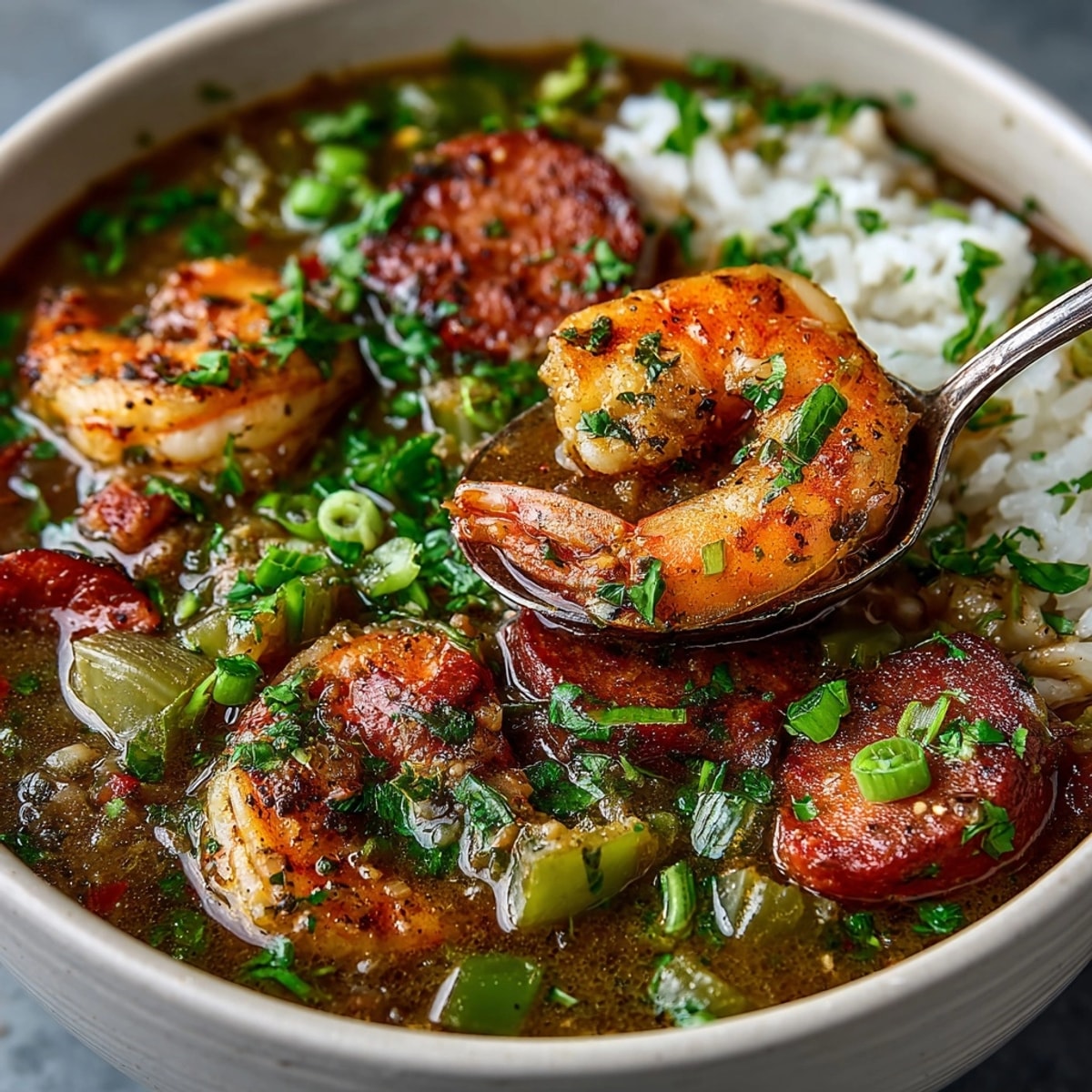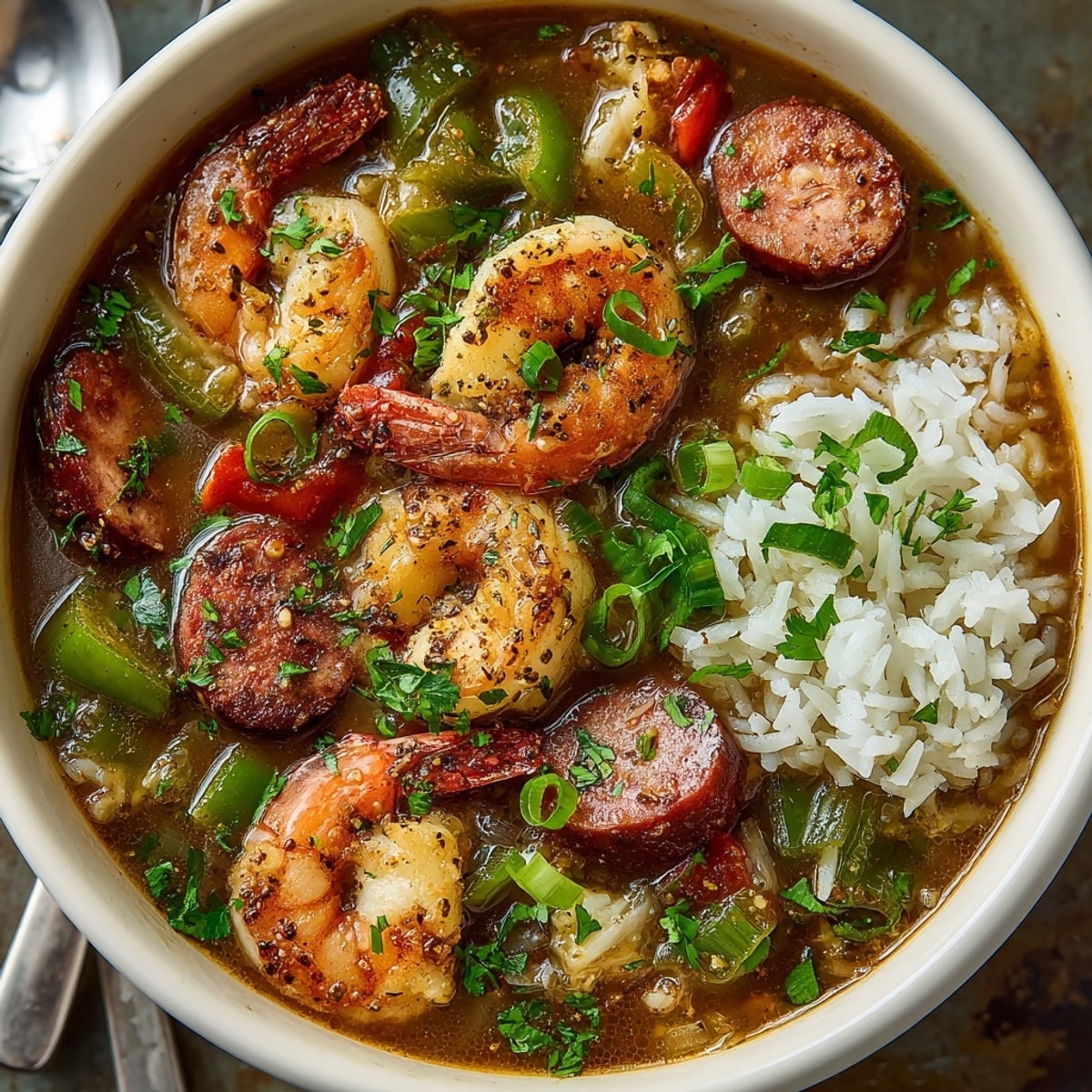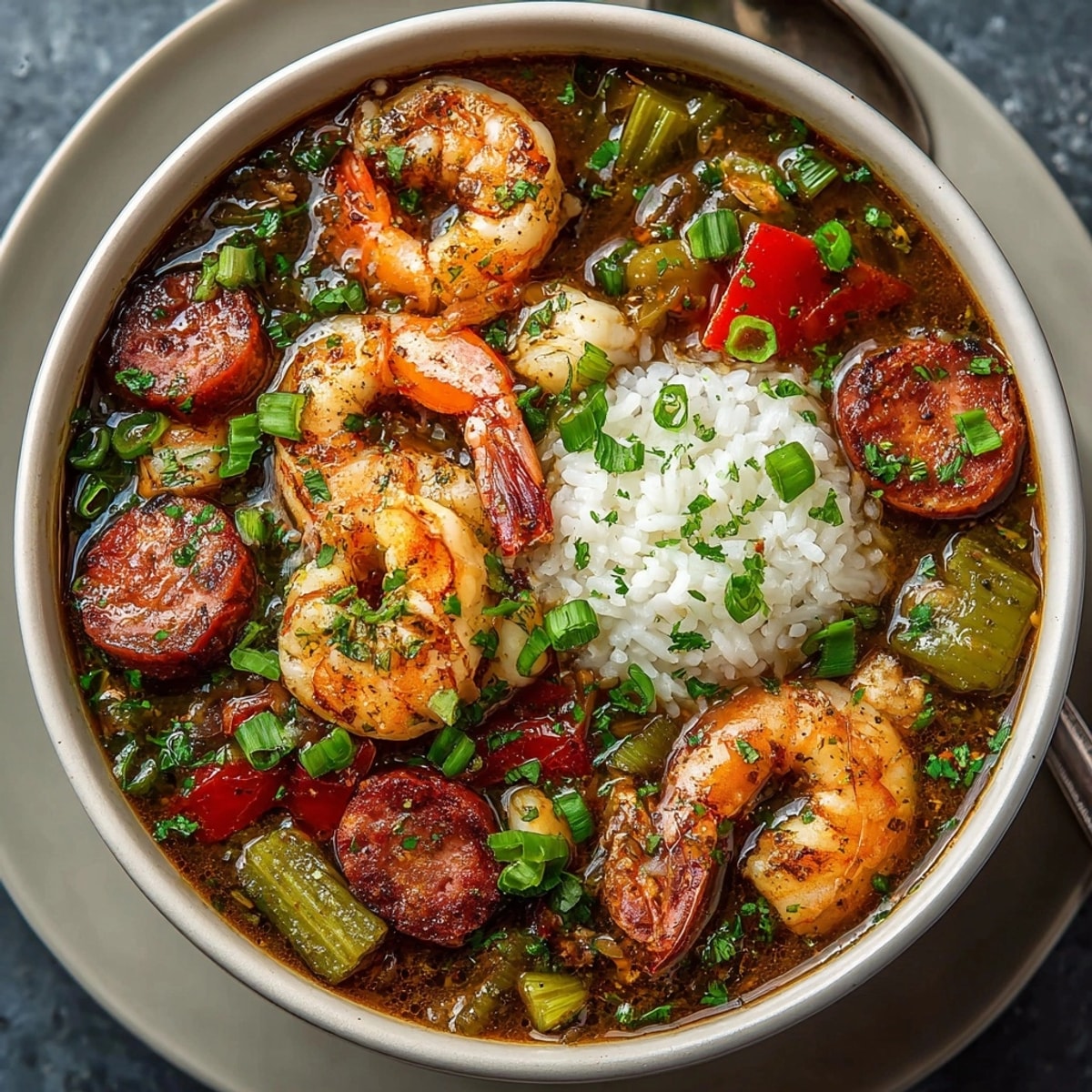 Save
Save Louisiana Seafood Gumbo brings the spirit of Creole kitchens right to your table with deep flavors and a feast of fresh Gulf seafood. Cooking this dish always fills my kitchen with a nostalgic, savory aroma that promises a celebration in every bowl. It is the ultimate comfort food for sharing with people you love.
The first time I made gumbo, I was amazed at how each step layered more flavor. My family now asks for it every time the weather turns chilly or we want something celebratory yet casual.
Ingredients
- All purpose flour: Essential for the roux which gives the gumbo its deep color and nutty undertone. Use fresh flour with no off smells.
- Vegetable oil: Helps develop the roux’s color and flavor. I use a neutral oil to let the other tastes shine.
- Andouille sausage: Adds signature smokiness and bite. Choose one with bold seasoning that holds up to simmering.
- Shrimp: Quick cooking and juicy. Ask your fishmonger for the freshest shrimp available and have them peel and devein if you can.
- Crab meat: Sweetness and delicate texture. Fresh lump or claw meat is ideal but quality canned works too.
- Green bell pepper: Part of the classic Holy Trinity for Creole dishes. Pick a firm, glossy pepper for the best taste.
- Celery: Provides aromatic backbone. Stalks should be crisp and bright green.
- Onion: Sweet and mellow after cooking. Yellow onions are traditional.
- Garlic: Brings depth. Look for plump cloves with no green sprouting.
- Chicken or seafood stock: Base of the broth. Homemade or low sodium boxed broths are best for clean flavor.
- Diced tomatoes: Optional but nice for brightness and body.
- Okra or filé powder: Thickens the gumbo and adds signature Southern flavor. Fresh okra pods slice cleanly and are not slimy when young.
- Bay leaves: Subtle earthiness. Dried Turkish bay leaves store well and impart lots of aroma.
- Dried thyme: Layers herby flavor. Rub between your fingers to revive its scent before adding.
- Cajun seasoning: Kick of heat and savory depth. Use your favorite blend or mix your own for more control.
- Worcestershire sauce: A dash brings an umami boost and subtle tang.
- Hot sauce: Lets you control the heat to taste.
- Salt and pepper: Fundamental for balancing all the flavors.
- Green onions: Fresh pop of color and oniony freshness.
- Fresh parsley: Bright finish for both garnish and taste.
- Cooked white rice: Serves as a hearty base for soaking up every drop of the gumbo.
Instructions
- Make the Roux:
- In a large heavy pot or Dutch oven, add the flour and oil over medium heat. Stir constantly with a wooden spoon or spatula for twenty to thirty minutes. Be patient and do not rush. The mixture will gradually turn from pale to a deep chocolate brown. This careful browning unlocks the roasted and nutty notes that define a great gumbo base. Take care not to let the roux burn or scorch at the bottom.
- Add the Vegetables:
- Immediately stir in the green bell pepper, chopped celery, onion, and minced garlic. Cook over medium heat for about five to seven minutes until the vegetables are deeply softened and fragrant. Their moisture also cools the roux and prevents overcooking.
- Brown the Sausage and Add Spices:
- Toss in the sliced andouille sausage. Let it render and brown slightly for another three to four minutes. This step adds richness and a smoky edge. Sprinkle in the bay leaves, dried thyme, and Cajun seasoning, stirring well so everything is coated with flavor.
- Simmer the Broth:
- Carefully pour in the chicken or seafood stock and add the optional diced tomatoes. Bring the mixture up to a gentle boil. Reduce the heat and let the gumbo bubble at a low simmer for forty five minutes. Stir occasionally and skim off any foam that appears. This long simmer encourages the deep layers of flavor to blend.
- Add Okra or Thicken with Filé Powder:
- Add sliced okra at this point, if using. Cook for an additional ten minutes. The okra will break down and subtly thicken the broth. If using filé powder, reserve it until just before serving and sprinkle it in for an earthy, slightly grassy finish.
- Cook the Seafood:
- Gently stir in the peeled and deveined shrimp and crab meat. Keep the heat medium low and simmer for about five to seven minutes until the shrimp are pink and opaque and the crab is just warmed through. Take care not to overcook the seafood.
- Season and Finish:
- Drizzle in Worcestershire sauce and a few generous dashes of hot sauce. Taste and adjust salt and pepper. Remove from the heat, discard the bay leaves, and stir in the chopped green onions and fresh parsley. Serve generous scoops of gumbo over warm cooked white rice for a satisfying meal.
 Save
Save One of my favorite ingredients here is the smoky andouille sausage. I remember my uncle, who taught me gumbo, always insisted on tasting a bite before choosing which links to buy. We still do taste tests together at the butcher every holiday season. There is always laughter in the kitchen when gumbo is involved.
Storage Tips
Gumbo tastes even better on the second day because the flavors have time to meld overnight in the refrigerator. Place leftovers in airtight containers. It will keep up to three days in the fridge or up to three months in the freezer. To reheat, gently warm in a pot over low heat and stir occasionally to keep the seafood tender and the broth smooth.
Ingredient Substitutions
Swap andouille sausage for kielbasa or any robust smoked sausage if you have trouble sourcing the classic. If fresh crab is unavailable, quality canned crab or even extra shrimp will work in a pinch. For vegetarians, use vegetable broth and skip the seafood and sausage, loading up on extra okra, mushrooms, and eggplant for a satisfying twist.
Serving Suggestions
Ladle the gumbo over fluffy white rice and finish with extra sprinkling of green onions and parsley. Add cornbread or crusty French bread on the side for mopping the bowl clean. Pair with a fresh lemony green salad if you like something crisp and bright to contrast the hearty stew.
Cultural Context
This gumbo embodies generations of Louisiana cooks blending West African, French, and Native American inspiration. The roux is French in origin. The okra has ties to West African cuisine. Filé powder comes straight from Native American Choctaw. Each bowl tells the story of the region’s food traditions.
Seasonal Adaptations
Use summer ripe tomatoes for the brightest broth in hot weather. Mix in extra fresh corn or diced zucchini in late summer for added sweetness. In winter, double down on the sausage and root vegetables for a richer, more warming dish.
Success Stories
Many home cooks have shared that gumbo became their go to special occasion meal after trying this recipe. Others have told me how children who claimed to hate seafood asked for seconds. Some say sharing gumbo made them fast friends at neighborhood block parties.
Freezer Meal Conversion
Allow the gumbo to cool completely, then portion into freezer safe bags or containers. Store the rice separately for best texture. Thaw the gumbo in the refrigerator overnight before slowly reheating on the stovetop. Always taste and add a bit more broth or water if needed.
 Save
Save This gumbo is a true celebration of flavor and tradition. Serve it with a smile and savor every bite with your loved ones.
Recipe Questions
- → What seafood can be used in Louisiana seafood gumbo?
Shrimp and crab are most common, but oysters or crawfish can be added for variety and richness.
- → How do I make a dark roux?
Continuously stir equal parts flour and oil over medium heat for 20–30 minutes until deep brown and fragrant.
- → Can this be made spicier?
Yes, increase Cajun seasoning or add cayenne pepper and hot sauce to reach your desired level of heat.
- → Is okra or filé powder necessary?
Okra or filé powder help thicken and add flavor, but either can be used based on availability or preference.
- → How should leftovers be stored?
Store in the refrigerator for up to 3 days or freeze for up to 3 months. Reheat gently on the stovetop.